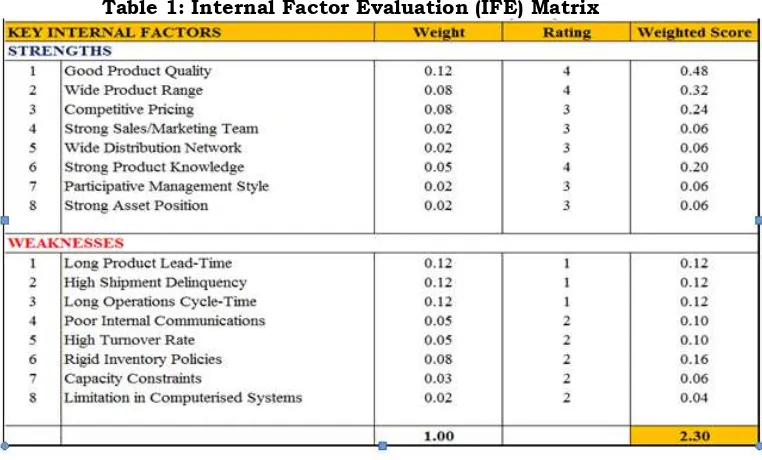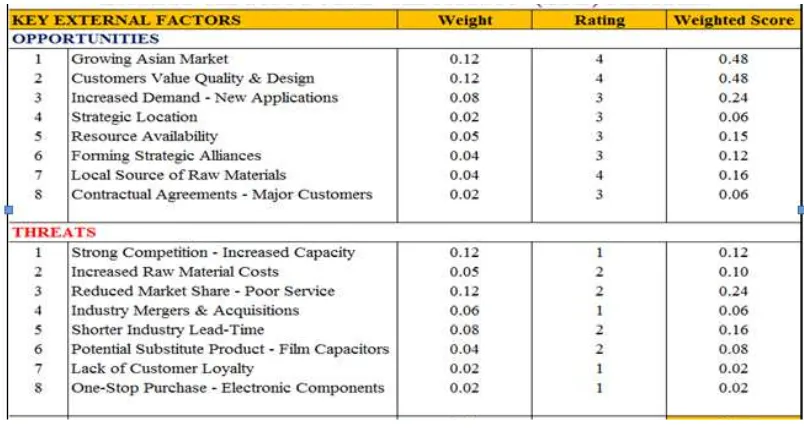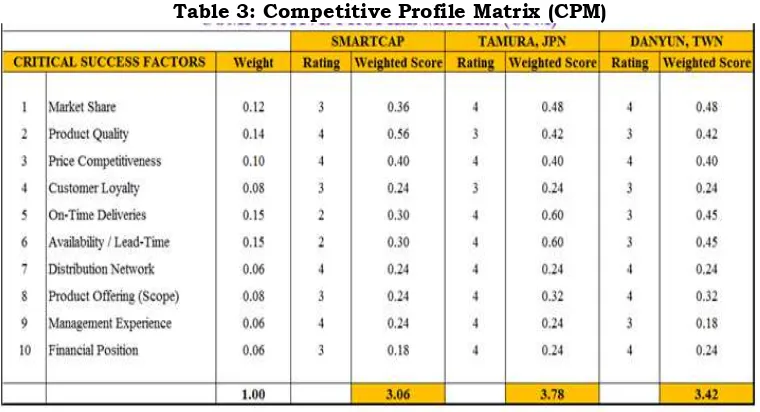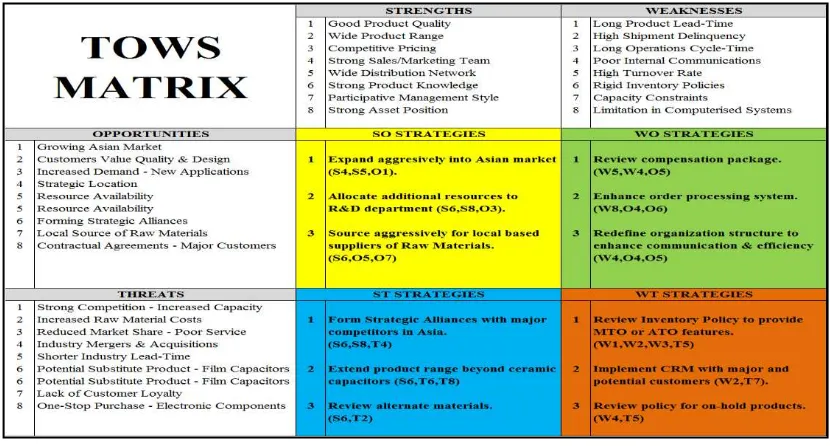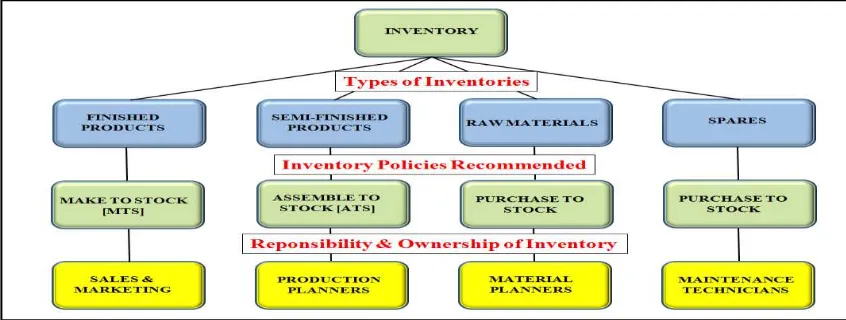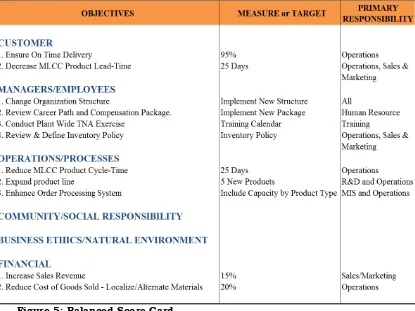Vol. 22, No. 1 August 2014 REDUCTION IN SHIPMENT DELINQUENCIES
AND PRODUCT LEAD TIME ON
ENHANCING CUSTOMER SERVICE:A CASE STUDY
Gopakumar1, K. Jayaraman2, SerajKiumarsi3
Abstract
Customer service plays an important role in an organization's ability to generate income and revenue. From this perspective, customer service should be included as part of an overall approach to systematic improvement. A customer service experience can change the entire perception a customer has of the organization. The present paper identifies the current weaknesses of an electronic company in terms of shipment delinquencies and long product lead-times and to propose recommendations to the company to overcome the issues towards enhancing customer service. The paper investigates the organizations’ internal and external environment factors towards establishing strengths and opportunities and further analyzing the various problems faced in order to establish the root-cause components. A list of recommendations are proposed through which the company may be able to enhance its level of customer service, increase its market share and sustain in the industry as a serious and viable contender.
Keyword: Shipment; Lead-Time; Product Inventory; Customer Service
Introduction
SmartCap is an electronic component manufacturing company which employs over 1200 employees and are specialized in the manufacturing of electronic passive components namely capacitors. Capacitors are components that are used to store an electrical charge and are used to regulate current in a circuit. There are various types of components however the focus of this paper will be on multi-layered ceramic capacitors (MLCC). According to industry experts, the Global MLCC market is expected to continue to increase with steady growth over the period 2013–2015. SmartCap receives orders from its sales offices strategically located all over the world via EDI (electronic data
1 PhD candidate, Graduate School of Business, Universiti Sains Malaysia, vgkfly@yahoo.com, Mobile: 0060124921545
2 Associate Professor, Graduate School of Business, Universiti Sains Malaysia, dr_kjraman@usm.my, Mobile: 0060103750868
interchange). Over the past several years, SmartCap has managed to extend superior service to its customers. However, since November ‘2012, there was a drastic decline in service which was due to a high number of delinquent shipments and extended product lead-time. Upon analysis of the annual customer satisfaction survey and plant key performance indicators, the issues are centered around the Chip Fabrication (front-end) process where product cycle-time has increased sharply due to several factors including resignations of technicians, capacity bottlenecks in operations, limitations to the order processing system, poor communication resulting in badly planned inventories of materials, supplies and machine spares. Due to the severity of the issue, as an interim action, management has decided to implement certain containment actions in order to reduce the impact to the customers with immediate effect. However, the root-causes must be identified and proper corrective actions must be implemented fast to avoid such recurrence.
Industry Profile
Vol. 22, No. 1 August 2014 marketplace, there is an increasing demand for lower prices and shorter deliveries.
Issues Faced
Over the past several years, SmartCap has managed to extend superior service to its customers. However, since November ‘2012, there was a drastic decline in service which was due to a high number of delinquent shipments and extended product lead-time.
The negative trend coupled with the poor financial results obtained in the last quarter of 2012 was alarming. Following a detailed analysis of the feedback received, the company arrived to the following 3 conclusions:
Frequent shipment misses (either shipments are late or quantity shipped does not meet the requirement of the customer). On time deliveries dropping far below the industry benchmark of 95%. Increased product lead-time which is higher than that of most competitors. Benchmark is 25 days upon receipt of order.
Shorter product delivery lead-time expectation due to reduced inventory levels maintained by distributors. Pan and Yang (2002) have constructed integrated inventory model with controllable lead time. implemented which were put in place with immediate effect:
Increased machine capacity by releasing additional machines to production. These machines were shut-off earlier as a cost-reduction plan in lieu of the weak sales forecast received from Sales and Marketing.
Pulled over a few quality inspectors from other product lines to MLCC to attend to the high number of parts on hold for rework to shorten the waiting time.
Pulled over a few technicians from other product lines to MLCC to address the high down-time issue.
Authorized material control to expedite and bring in raw materials and immediately realised about 20% drop in orders. In order to reduce the impact to the bottom line performance, management decided to take certain actions as a cost-reduction effort in line with the weaker booking rate. Hayya et al., (2011) have studied the impact of stochastic lead time reduction on inventory cost under order crossover.
The following actions were implemented:
No overtime (the previous quarter the plant was running with 12% overtime)
Reduce number of machines in production by 20% with the intent of aligning capacity to forecast number.
Cut down overhead expenses by 20%.
Reduced the purchase of supplies and materials by 20%. Cancel orders/postpone deliveries.
Redeploy operators and technicians to other lines and arrange for cross-training in the Training Department.
However, when the On-Time Delivery indicator dropped sharply in November ‘2012 and continued on a declining trend till February ‘2013; management was pressed to look for answers immediately. Matters became worse when the Customer Satisfaction Index for the year 2012 was published. Due to shipment misses and longer lead-times, customers started to cancel orders.
The situation forced management to immediately take containment actions discussed above to reduce the impact to the customers. Meanwhile, in parallel, urgent attention is required to determine the root-cause and implement corrective actions accordingly in order to avoid such recurrence. Factors that contributed to the poor service are all discussed in detail here.
Preventive Maintenance Schedule
Vol. 22, No. 1 August 2014 machines was the resignation of several experienced technicians in the front-end process in September ‘2012. After careful analysis, it was identified that these technicians despite their seniority in the line, they are paid about the same wages earned by a newly hired diploma-certified technician. Most of these experienced technicians rose from rank and file and do not possess the required paper qualifications to move up the scale. This created dissatisfaction amongst them.
Availability of Spares / Machine-Parts
Spares and machine parts were maintained in the warehouse. Ordering of parts and establishment of safety level of spares were based strictly on usage history and sales forecast. However, due to the ad-hoc and unplanned release of machines to Engineering for preventive maintenance and calibration work, the purchasing personnel were unable to track correctly the usage as they were not given the right information in a timely manner. Purchasing personnel were not being made aware of the preventive maintenance schedule and the critical parts that were required for this process. Also, the frequent change in the preventive maintenance schedule made it more difficult for them to plan for these spare-parts.
Availability of Raw Material
Raw materials were maintained in the warehouse. Material controllers order raw materials and establish their safety level based on historical consumption patterns and monthly order forecast received from Sales & Marketing. Due to incorrect or unreliable forecast received from Sales & Marketing, the material controllers will have to plan for pull-ins or push-outs accordingly. This has the tendency to lead to material stock-out which eventually brings down production machines resulting in delays and a loss of capacity.
Capacity Bottlenecks in Production
the production cycle-time which eventually led to shipment delays and longer product lead-time resulting in poor customer service performance.
Method of Analysis
In the above sections, various issues that could lead to the current poor customer service levels were reviewed. Before going into the details and identifying the root-causes, it will be good to carry out an in-depth internal and external environment assessment of the organization. This is needed to understand clearly the internal strengths and weaknesses of the organization versus the external opportunities and threats faced by the organization. For this purpose, I will use the Internal Factor Evaluation (IFE) matrix and External Factor Evaluation (EFE) matrix. From here, the TOWS analysis will be used to formulate appropriate strategies. A further matrix called the Competitive Profile Matrix (CPM) is used to identify the organization’s strengths and weaknesses of the business unit and the organization at large. The major strengths of the organization are detailed below:
Good Product Quality – Products of SmartCap are renowned for its product quality and are mostly superior to competitor’s products. This is a result of high quality raw materials which are used in the process.
Wide Product Range – SmartCap has a diversified range of ceramic
capacitors and offer products ranging from low capacitance to
Vol. 22, No. 1 August 2014
Strong Product Knowledge – The plant has been in the business for more than 20 years. There has also been a substantial technology transfer from the US and Europe plants.
Participative Management Style– Management is actively involved in day-to-day business issues. All managers are hands on and have received proper and adequate training.
Strong Asset Position – The plant is in a strong financial position and has carried out some significant strategic alliance formation in Europe and US. Cash flow is healthy.
On the other hand, there were also several weaknesses identified:
Long Product Lead Time – Due to the stringent cost-reduction exercise carried out, Operations were under immense pressure to deliver products efficiently. This caused an increase in the cycle-time in accordance to industry lead-cycle-time resulted in Operations being unable to meet the volume in a timely manner. The change in product mix plus the inflexible machine changeover led to the violation of the FIFO (First-In, First-Out) rule which resulted in delinquencies.
Long Operations Cycle Time – Frequent machine down-time and accumulation of lots at the quality control gate as a result of using non-qualified machines on the line created a huge impact to the cycle-time at the Chip Fabrication process. Ouyang et al., (2007) studied an integrated vendor–buyer inventory model with quality improvements and lead time reduction.
Poor Internal Communications – Changes in periodic maintenance schedule and re-scheduling of orders were not communicated well to the Purchasing department which ended up with inaccurate purchases of supplies, spare-parts and raw materials.
High Turnover Rate – Experienced and senior technicians were not compensated accordingly and felt that they were treated unfairly as new hires with proper paper qualifications were paid better.
Rigid Inventory Policies – Despite many calls from the planners to
Marketing were unable to provide a clear and accurate forecasts as well.
Capacity Constraints – The plant had limited capacity for certain
product mix and this created a bottleneck in Operations. Tools to carry out these changeovers were limited and Operations prefer to group these products to be processed at once to minimize changeovers.
Limitation in Computerised Systems – The existing Order-Processing system did not have the capability to manage production capacity by product mix and this often resulted in over-commitment of customer order that led to service failures.
Table 1 below identifies the plant’s key strengths and its weaknesses. The overall score achieved by the plant is 2.30 which indicates a below average achievement.
Table 1: Internal Factor Evaluation (IFE) Matrix
External Assessment
The objective of the External Assessment is to identify the key opportunities that could benefit the plant and threats that should be avoided. This will enable the plant to respond offensively or defensively to the factors by formulating strategies that take advantage of external opportunities or that minimize the impact of potential threats. The major opportunities are presented below:
Vol. 22, No. 1 August 2014 increase in purchasing power for electronic devices and mobile phones, have had a direct impact to the demand for ceramic capacitors.
Customers Value Quality & Design – Despite the price war due to mushrooming competitors, customers still prefer high quality components with flexible designs.
Increased Demand from New Applications – The growth of the electronic sector particularly in mobile devices such as smart-phones, modems, tablet computers and Global Positioning Devices have had a direct impact as well to the demand of ceramic capacitors.
Strategic Location – The plant and its sales and marketing teams are strategically located to offer customers personalized efficient service. The possibility to react faster and adapting to changing demands faster gives the plant an advantage.
Resource Availability – With its massive population and strong growth, resources (in terms of labour, equipment and supplies) are easily available for rapid expansion exercises.
Forming Strategic Alliance– SmartCap should take advantage of the market in Asia by forming strategic alliances with major competitors. Its strength in quality and product knowledge would make it a suitable partner for many new players in the field (particularly in China) who has huge capacities and vast resources.
Local Source of Raw Materials – Due to the rapid increase in electronic manufacturing plants in Asia, the plant can take advantage of local suppliers to replace the overseas suppliers. This automatically reduces the level of inventories the plant has to hold due to shorter raw material lead-times. Suppliers will also be more flexible to adapt to demand changes faster.
Contractual Agreements with Major Customers – The plant can take the initiative to set up contractual agreements with major customers and work with them closely to identify demands for niche products. Setting a Customer Relationship Management (CRM) strategy with core customers will also help in identifying potential changes in demand thus making room for more accurate forecasts.
However, apart from opportunities there are also potential threats that the plant should avoid:
Government. Their objective is match and lower prices in the market irrespective of their cost structure. Losses are being absorbed by the Government and their long-term strategy is to wipe out competitors thus resulting in enjoying larger market share.
Increased Raw Material Costs – Prices of raw materials especially precious materials such as Nickel, Tin, Zinc, Copper and Palladium are increasing due to the higher demands from the Chinese manufacturers.
Reduced Market Share – Despite competitive prices and superior product quality, the plant is at risk of losing its market share due its poor service, longer lead-time and frequent shipment delinquencies.
Industry Mergers & Acquisitions – Most of the players in the market are getting into mergers and acquisition in order to have a larger capacity and more diversified product offering.
Shorter Industry Lead-Time – Competitors are willing to hold stock for customers thus improving the availability of capacitors. This gives them a superior advantage over competition in terms of lead-time.
Potential Substitute Products – The huge popularity of ceramic capacitors have also gone un-noticed by other passive components makers. Film capacitor and tantalum capacitor makers are also rapidly increasing their product availability and lowering their prices in order to get into this market.
Lack of Customer Loyalty – In the capacitor business, it is often very difficult to engage customer loyalty. Loyalties are only formed when the manufacturer can constantly deliver superior quality products in a timely manner at the right cost. There are ample choices in the market for customers to choose from.
One-Stop Purchases – Most electronic applications needs a range of passive electronic components in order to build a complete module. This involves resistors, capacitors, inductors as well as other components. The trend in the industry is moving rapidly to one-stop purchases whereby a supplier who can provide the entire combination of passive components would definitely have an edge over its competitors.
Table 2 below illustrates the plant’s position with respect to external opportunities and threats. The plant achieves an average score of 2.55.
Vol. 22, No. 1 August 2014 Market Positioning
Table 3: Competitive Profile Matrix (CPM)
Recommendations
Vol. 22, No. 1 August 2014 Figure 1: Fish Bone Analysis
Strategy Formulation
After assessing the internal factors to identify strengths and
weaknesses and identifying the opportunities and threats through the external evaluation, a major step towards strategy formulation is to match the key internal and external factors. TOWS matrix provides a framework that helps the organization to focus on its strengths while minimizing weaknesses and to take the greatest possible advantage of opportunities while avoiding the threats. Figure 2 below illustrates the 4 types of strategies (SO – Strengths versus Opportunities, WO – Weaknesses versus Opportunities, ST – Strengths versus Threats and WT – Weaknesses versus Threats) that should be used by SmartCap.
In order to sustain in this competitive environment, various strategies have been identified resulting from in-depth analysis of the case above. The major issue is directed towards improving the efficiency and effectiveness of the plant towards achieving higher levels in customer satisfaction. These strategies can be classified into two categories; short-term strategies and long-term strategies.
Short-Term Strategies
Vol. 22, No. 1 August 2014
Review Organization Structure
From the analysis above, several occurrences of poor communications have been identified. This is largely related to the form of organization structure in place which is very functional. Taking this as well as potential extension of product range into consideration, the need to emphasize focus and control is essential for sustainability. For this reason, it is proposed that the plant may adapt a Strategic Business Unit (SBU) organization structure as depicted in Figure 3. The advantages of an SBU structure includes improved communications, clear allocation of resources and narrowed as well as focussed objectives are established.
Figure 3: Strategic Business Unit organization structure
The MLCC operations manager will have total control over the maintenance, planning and material control activities. It provides an avenue for enhanced communication and control within the department. Process engineering will be tasked to review process improvement projects as well as to monitor in process quality indicators which will prevent the use of non qualified machines in operations thus reducing the need for a second quality buy-off for non-conforming products which eventually leads to reduced level of oh-hold lots resulting in improved cycle-time. On the other hand, there will be closed follow-up and tracking of materials and spares on the line with the involvement of the planning and material control group. There will also be closer working relationships established between the production and maintenance group to avoid reschedules of preventive maintenance activities as well as to achieve a quicker turn-around time to bring up machines which directly relates to increased capacity.
Review Inventory Policy
The plant should not be made accountable for this stock. It should be the primary responsibility of the Sales and Marketing team to define the safety level as well as to ensure these products are eventually sold to customers. This safety stock will also act as a buffer to operations in the event of some unforeseen circumstances whereby customer expectations are still being met despite longer cycle-times in production. It also helps the plant to secure orders requiring shorter delivery dates. On the other hand, to further improve the situation, the plant should plan as well for ATO (assemble to order) on certain products. These are semi-finish products maintained in inventory and the responsibility to keep this inventory in check should fall squarely on the shoulders of the MLCC Operations Manager. The flexibility it provides is because one semi-finish product can be linked to several finished products and the production planners should carefully monitor and manage these products by linking them to products required by customers; thus shortening the lead-time for shipment. The proposed organization and management of plant inventories are illustrated in Figure 4. A periodic 6 monthly audit should be carried out by management to review these inventories.
Figure 4: Flow of Inventory Management
Address Issues Related to Employee Development and
Compensation
Vol. 22, No. 1 August 2014 the chance to move up the ladder. This creates room for resentment and dissatisfaction among employees. To overcome this, it is proposed that and position themselves on the same job grade as someone who lacks in experience but has the required paper qualification. On the other hand, the management path provides staffs with an opportunity to be in the management team. In addition, a plant wide Training Needs Analysis (TNA) exercise also needs to be carried out across the plant with immediate and urgent focus on technician’s capability and skill levels.
Enhance Order Processing System
The missing link in the current order processing system is the capability to manage capacity and bottleneck by various types of products. This feature is very critical for production planners and customer service personnel to provide accurate lead-times to the customer as well as to refrain from over-committing orders on a particular product. Management must seriously consider this issue and take appropriate steps to overcome this shortcoming. This strategy should be noted as a short to medium term strategy for the plant.
Qualifying Local or Alternate Sources for Raw Materials
In order to cut-down the lead-time involved in purchasing raw materials especially for those that are overseas sourced, management need to establish a project team comprising of process engineers, material controllers, quality engineers and the purchasing team to localize these materials. This can be done in stages starting with most critical items first. Apart from shortening the lead-time, there are other benefits that can be derived with localizing purchases of materials which includes lower price and lower inventories as well more frequent deliveries can be arranged.
Long-Term Strategies
needs of these customers. Reducing shipment delinquencies and product lead-times towards enhancing customer service should be considered on a wider scale and should be forward-looking.
Downsides Management
The biggest downside to the strategies recommended above is the resistance to change following the alteration of the existing organization structure. Despite the fact that no individual or organization can escape change, it however raises anxieties because people fear economic loss, inconvenience, uncertainty and a break in normal social patterns. Resistance to change is a great threat to successful strategy implementation and it can take the form of sabotaging, absenteeism, unwillingness to cooperate and filing unfounded grievances. People often resist because they do not understand what is happening or why the changes are taking place. Successful strategy implementation hinges upon top managements’ ability to develop an organization climate which is conducive to change. Change must be viewed as an opportunity rather than as a threat. Since change involves everyone in the organization as well as all levels of the management team; from lower level managers to senior managers, therefore it is essential to involve them as much as possible from the initial stages. Clear, concise and regular communications are also important to ensure that employees understand the reasons leading to the changes and what is expected of them. It is also important to convince employees that this change is to their personal advantage.
Strategy Implementation
In order to overcome this resistance, the following additional actions are necessary to ensure smooth implementation.
Establishing annual objectives
Vol. 22, No. 1 August 2014 Figure 5: Balanced Score Card
Formation of Policies
Policies are required to make a strategy work. They set boundaries, constraints, and limits on the kinds of administrative actions taken. They clearly let both employees and managers know what is expected of them. They also provide a basis for management control, allow coordination across business units and reduce the amount of time spent by managers on decision making.
Allocation of Resources
Resources should be allocated in accordance with organization priorities indicated by the annual objectives. There are 4 types of resources which are financial resources, physical resources, human resources and technological resources. The real value of resource allocation lies in the resulting accomplishment of organization objectives.
Managing Conflict
perception amongst employees. Conflict is unavoidable in organizations, so it is important that conflict be managed and resolved before it affects performance.
Conclusions
Vol. 22, No. 1 August 2014 References
Bromley M. &Cuthbertson R. (2006), Managing Performance: Ambition into Action, paper, Strategy and Performance Management: Practitioner Perspectives, BAM-ESRC research seminar, UEA, September.
Conklin, Michael (2006), Measuring and Tracking Customer Satisfaction, MarketTools Inc.
David F.R. (2011), Strategic Management: Concepts and cases (13th Edition International), London: Pearson Education International.
Gunn R. & Williams W. (2007), Strategic Tools: An empirical investigation into strategy in practice in the UK, Strategic Change, 16, 201-16.
Hayya, J.C, Harrison, T.P, and He, X.J.(2011).The impact of stochastic lead time reduction on inventory cost under order crossover,
European Journal of Operational Research, vol. 211, pp. 274– 281.
Ouyang, L. Y., Wu, K. S.andHo, C. H.,(2007). An integrated vendor– buyer inventory model with quality improvement and lead time reduction, International Journal of Production Economics, 108(2),349–358.
Pan, C.H.J.and Yang, J.S., (2002). A study of an integrated inventory with controllable lead time, International Journal of Production Research, 40(5), 1263–1273.
Richard J. Tersine, Edward A. Hummingbird, (1995). Lead-time reduction: the search for competitive advantage, International Journal of Operations & Production Management, 15 (2), 8 – 18.
Saibal Ray, Jewkes, E.M., (2004). Customer lead time management when both demand and price are lead time sensitive, Stochastics and Statistics, European Journal of Operational Research 153, 769–781.
